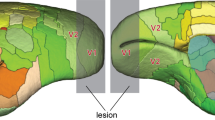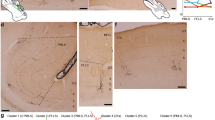Abstract
In intact cats, it is generally considered that the lateral posterior-pulvinar complex (LP-pulvinar) does not receive direct retinal terminals, with the exception of the retino-recipient zone known as the geniculate wing. There is, however, some evidence that early lesions of the visual cortex can occasionally induce the formation of novel retinal projections to the LP nucleus. Given the importance of knowing the connectivity pattern of the LP-pulvinar complex in intact and lesioned animals, we used the B fragment of cholera toxin, a sensitive anterograde tracer, to reinvestigate the retinal projections to the LP-pulvinar in normal cats and in cats with early unilateral lesions of the visual cortex (areas 17 and 18). Immunohistochemical localization of the toxin was performed to show the distribution and morphology of retinofugal terminals. A direct bilateral but predominantly contralateral retinal projection reached the caudal portion of LPl and LPm in the form of patches located mainly along its dorsomedial surface and many scattered terminals. The distribution of retinal projections to LP-pulvinar in intact and operated cats did not differ. Contrary to what had been previously reported, we found no evidence for lesion-induced sprouting of retinal axons in these higher-order thalamic nuclei. Retinal input to the LP-pulvinar might modulate visual responses driven by primary visual cortex or superior colliculus.







Similar content being viewed by others
References
Agarwala S, Petry HM, May JG (1989) Retinal projections in the ground Squirrel (Citellus tridecemlineatus). Vis Neurosci 3:537–549
Angelucci A, Clasca F, Sur M (1996) Anterograde axonal tracing with the subunit B of cholera toxin: a highly sensitive immunohistochemical protocol for revealing fine axonal morphology in adult and neonatal brains. J Neurosci Methods 65:101–112
Berman N, Jones EG (1977) A retino-pulvinar projection in the cat. Brain Res 164:237–248
Boire D, Casanova C, Ptito M (2000) Retinal projections to the lateral posterior-pulvinar in normal and striate cortex ablated cats: a cholera toxin B fragment study. Society for Neuroscience Abstracts 26(1-2): 549.13
Bronchti G, Rado R, Terkel J, Wollberg Z (1991) Retinal projections in the blind mole rat: a WGA-HRP tracing study of natural degeneration. Dev Brain Res 58:159–170
Bruce LL, Kicliter E (1984) A study of retinal projections in the ground squirrel, (Spermophilus tridecemlineatus) using anterograde transport techniques. P R Health Sci J 3:97–106
Casanova C (2003) Functions of the pulvinar in vision. In: Chalupa LM, Werner JS (eds) The visual neurosciences. MIT Press, Cambridge MA, pp 592–608
Casanova C, Freeman RD, Nordmann JP (1989) Monocular and binocular response properties of cells in the striate-recipient zone of the cat’s lateral posterior-pulvinar complex. J Neurophysiol 62:544–557
Casanova C, Savard T, Darveau S (1997) Contribution of area 17 to cell response in the striate-recipient zone of the cat’s lateral posterior-pulvinar complex. Eur J Neurosci 9:1026–1036
Casanova C, Merabet L, Desaultels A, Minville K (2001) Higher-Order motion processing in the pulvinar. Prog Brain Res 134:71–82
Clancy B, Darlington RB, Finlay BL (2001) Translating developmental time across mammalian species. Neuroscience 105:7–17
Costa MS, Santee UR, Cavalcante JS, Moraes PR, Santos NP, Britto LR (1999) Retinohypothalamic projections in the common marmoset (Callithrix jacchus): a study using cholera toxin subunit B. J Comp Neurol 415:393–403
Crain BJ, Hall WC (1980) The organization of afferents to the lateral posterior nucleus in the golden hamster after different combination of neonatal lesions. J Comp Neurol 193:403–412
Cunningham TJ (1972) Sprouting of the optic projections after cortical lesions. Anat Rec 172:298
Cunningham TJ, Huddelston C, Murray M (1979) Modification of neuron numbers in the visual system of the rat. J Comp Neurol 184:423–434
Dumbrava D, Faubert J, Casanova C (2001) Global motion integration in the cat’s lateral posterior-pulvinar complex. Eur J Neurosci 13:2218–2226
Erzumulu RS, Jhaveri S, Schneider GE (1988) Distribution of morphological different axon terminals in the hamster dorsal lateral geniculate nucleus. Brain Res 461:175–181
Fite KV, Janusonis S, Foote W, Bengston L (1999) Retinal afferents to the dorsal raphe nucleus in rats and Mongolian gerbils. J Comp Neurol 414:469–484
Graybiel AM, Berson DM (1980) Histochemical identification and afferent connections of subdivisions in the lateralis posterior-pulvinar complex and related thalamic nuclei in the cat. Neuroscience 5:1175–1238
Guido W, Spear PD, Tong L (1990) Functional compensation in the lateral suprasylvian visual area following bilateral visual cortex damage in kittens. Exp Brain Res 83:219–224
Guillery RW, Geisert EE, Polley EH, Mason CA (1980) An analysis of the retinal afferents to the cat’s interlaminar nucleus and to its rostral extension the “geniculate wing”. J Comp Neurol 194:117–142
Harman AM, Coleman LA, Beazley LD (1990) Retinofugal projections in a marsupial, Tarsipes rostratus (Honey possum). Brain Behav Evol 36:30–38
Hutchins B, Updyke BV (1989) Retinotopic organization within the lateral posterior complex of the cat. J Comp Neurol 285:359–398
Itoh K, Mizuno N, Kudo M (1983) Direct retinal projections to the lateroposterior and pulvinar nuclear complex (LP-Pul) in the cat, as revealed by anterograde HRP method. Brain Res 276:325–328
Kawamura S, Fukushima N, Hattori S (1979) Topographical origin and ganglion cell type of the retino-pulvinar projection in the cat. Brain Res 173:419–429
Kudo M, Nakamura Y, Moriizumi T, Tokuno H, Kitao Y (1988) Direct retinal projections to the lateroposterior thalamic nucleus (LP) in the mole. Neurosci Lett 93:176–180
Ling C, Schneider GE, Northmore D, Jhaveri S (1997a) Afferents from the colliculus, cortex and retina have distinct terminal morphologies in the lateral posterior thalamic nucleus. J Comp Neurol 388:467–483
Ling C, Jhaveri S, Schneider GE (1997b) Target- as well as source-derived factors direct the morphogenesis of anomalous retino-thalamic projections. J Comp Neurol 388:454–466
Ling C, Schneider GE, Jhaveri S (1998) Target-specific morphology of retinal axon arbors in the adult hamster. Vis Neurosci 15:559–579
Lomber SG, MacNeil MA, Payne BR (1995) Amplification of thalamic projections to middle suprasylvian cortex following ablation of immature primary visual cortex in cat. Cereb Cortex 2:166–191
Major DE, Rodman HR, Libedinsky C, Karten HJ (2003) Pattern of retinal projections in the California ground squirrel (Spermophilus beecheyi): anterograde tracing study using cholera toxin. J Comp Neurol 463:317–340
Mason R (1981) Differential responsiveness of cells in the visual zones of the cat’s LP-pulvinar complex to visual stimuli. Exp Brain Res 43:25–33
Merabet L, Desautels A, Minville K, Casanova C (1998) Motion integration in a thalamic visual nucleus. Nature 396:265–268
Mikkelsen JD (1992) Visualization of efferent retinal projections by immunohistochemical identification of cholera toxin subunit B. Brain Res Bull 28:619–623
Murphy EH, Grigonis AM, Hayden TE, Tashayyod D, Wilkes M (1988) The effect of ablation of visual cortex in neonatal rabbits on the organization of retinothalamic and retinopretectal projections. Dev Brain Res 38:27–35
Payne BR, Foley HA, Lomber SG (1993) Visual cortex damage-induced growth of retinal axons into the lateral posterior nucleus of the cat. Vis Neurosci 10:747–752
Payne BR, Lomber SG, Macneil MA, Cornwell P (1996) Evidence for greater sight in blindsight following damage of primary visual cortex early in life. Neuropsychologia 34:741–774
Payne BR, Lomber SG, Gelston CD (2000) Graded sparing of visually-guided orienting following primary visual cortex ablations within the first postnatal month. Behav Brain Res 117:1–11
Perry VH, Cowey A (1979) Changes in retino-fugal pathways following cortical and tectal lesions in neonatal and adult rats. Exp Brain Res 35:97–108
Reiner A, Zhang D, Eldred WD (1996) Use of the sensitive anterograde tracer cholera toxin fragment B reveals new details of the central retinal projections in turtles. Brain Behav Evol 48:307–337
Reinoso-Suárez F (1961) Topographischer Hirnatlas der Katze. Herausgegeben von E Merck AG, Darmstadt
Restrepo CE, Manger PR, Innocenti GM (2002) Retinofugal projections following early lesions of the visual cortex in the ferret. Eur J Neurosci 16:1713–1719
Reuss S, Fuchs E (2000) Anterograde tracing of retinal afferents to the tree shrew hypothalamus and raphe. Brain Res 874:66–74
Royce GJ, Ward JP, Harting JK (1977) Retinofugal pathways in two marsupials. J Comp Neurol 170:391–414
Sanderson KJ, Pearson LJ (1977) Retinal projections in the Tasmanian devil, Sarcophilus harrisii. J Comp Neurol 188:335–345
Sanderson KJ, Pearson LJ, Haight JR (1979) Retinal projections in the native cat, Dasyurus viverrinus. J Comp Neurol 174:347–357
Schneider GE (1970) Mechanisms of functional recovery following lesions of visual cortex or superior colliculus in neonate and adult hamsters. Brain Behav Evol 3:295–323
Sherman SM, Guillery RW (2001) Exploring the thalamus. Academic Press, San Diego
Shimizu T, Cox K, Karten HJ, Britto LR (1994) Cholera toxin mapping of retinal projections in pigeons (Columbia livia), with emphasis on retinohypothalamic connections. Vis Neurosci 11:441–446
Spear PD, Kalil R, Tong L (1980) Functional compensation in lateral suprasylvian visual area following neonatal visual cortex removal in cats. J Neurophysiol 43:851–869
Takahashi ES, Hickey TL, Oyster CW (1977) Retinogeniculate projections in the rabbit: an autoradiographic study. J Comp Neurol 175:1–12
Tong L, Kalil R, Spear PD (1984) Critical periods for functional and anatomical compensation in the lateral suprasylvian visual area following removal of visual cortex in cats. J Neurophysiol 52:941–960
Updyke BV (1977) Topographic organization of the projections from cortical areas 17, 18 and 19 onto the thalamus, pretectum and superior colliculus in the cat. J Comp Neurol 173:81–122
Uchida K, Mizuno N, Sugimoto T, Itoh K (1982) Autoradiographic demonstration of retinal projections to the brain stem structures in the rabbit using transneuronal tracing technique with special reference to the retinal projections to the inferior olive. Exp Neurol 78:369–379
Acknowledgements
This study was supported by CIHR (Canada) operating grants to M.P. and C.C. Part of the salary of C.C. is provided by FRSQ (Québec).
Author information
Authors and Affiliations
Corresponding author
Rights and permissions
About this article
Cite this article
Boire, D., Matteau, I., Casanova, C. et al. Retinal projections to the lateral posterior-pulvinar complex in intact and early visual cortex lesioned cats. Exp Brain Res 159, 185–196 (2004). https://doi.org/10.1007/s00221-004-1946-6
Received:
Accepted:
Published:
Issue Date:
DOI: https://doi.org/10.1007/s00221-004-1946-6




